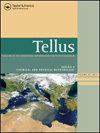雏菊世界的自续温度振荡
IF 2.3
4区 地球科学
Q3 METEOROLOGY & ATMOSPHERIC SCIENCES
Tellus Series B-Chemical and Physical Meteorology
Pub Date : 1999-09-01
DOI:10.1034/J.1600-0889.1999.T01-3-00005.X
引用次数: 29
摘要
沃森和洛夫洛克的雏菊世界模型表明,一个简单的生物反馈系统,包括黑白雏菊和它们的物理环境之间的耦合,可以在很大的太阳亮度范围内稳定行星温度。在这里,我们证明了在原始的菊花世界模型中加入一个温度微分方程会导致温度在一个稳态平均值附近的周期性振荡。在这些振荡中,模型在黑色雏菊或白色雏菊的主导地位之间交替,这是由系统的内部动力学而不是外部强迫引起的。发生振荡的一个重要标准是太阳光度在两种雏菊都能存活的范围内。第二个重要的判据是雏菊种群更替与气候系统热响应的时间尺度之比是有界的。虽然内部驱动振荡在捕食者-猎物生物模型和海洋能量平衡-冰冻圈耦合模型中是众所周知的,但本研究表明,这种振荡也可能出现在生物圈与其物理环境耦合的模型中。讨论了这一结果对地球和地球生理学的潜在意义。DOI: 10.1034 / j.1600 0889.1999.t01 - 3 - 00005. x本文章由计算机程序翻译,如有差异,请以英文原文为准。
Self-sustained temperature oscillations on Daisyworld
The daisyworld model of Watson and Lovelock demonstrated that a simple biological feedback system involving coupling between black and white daisies and their physical environment can stabilize planetary temperature over a wide range of solar luminosity. Here, we show that the addition of a differential equation for temperature to the original daisyworld model leads to periodic oscillations in temperature about a homeostatic mean. These oscillations, in which the model alternates between dominance by either black or white daisies, arise from the internal dynamics of the system rather than from external forcing. An important criterion for the oscillations to occur is that solar luminosity be within the range in which both daisy species are viable. A second important criterion is that the ratio of the timescales for daisy population turnover and climate system thermal response be bounded. While internally driven oscillations are well known in predator–prey biological models and in coupled ocean energy balance– cryosphere models, the present study shows that such oscillations also can arise in a model of the biosphere coupled to its physical environment. The potential significance of this result to planet Earth and the science of geophysiology is discussed. DOI: 10.1034/j.1600-0889.1999.t01-3-00005.x
求助全文
通过发布文献求助,成功后即可免费获取论文全文。
去求助
来源期刊
自引率
0.00%
发文量
3
期刊介绍:
Tellus B: Chemical and Physical Meteorology along with its sister journal Tellus A: Dynamic Meteorology and Oceanography, are the international, peer-reviewed journals of the International Meteorological Institute in Stockholm, an independent non-for-profit body integrated into the Department of Meteorology at the Faculty of Sciences of Stockholm University, Sweden. Aiming to promote the exchange of knowledge about meteorology from across a range of scientific sub-disciplines, the two journals serve an international community of researchers, policy makers, managers, media and the general public.

 求助内容:
求助内容: 应助结果提醒方式:
应助结果提醒方式:


